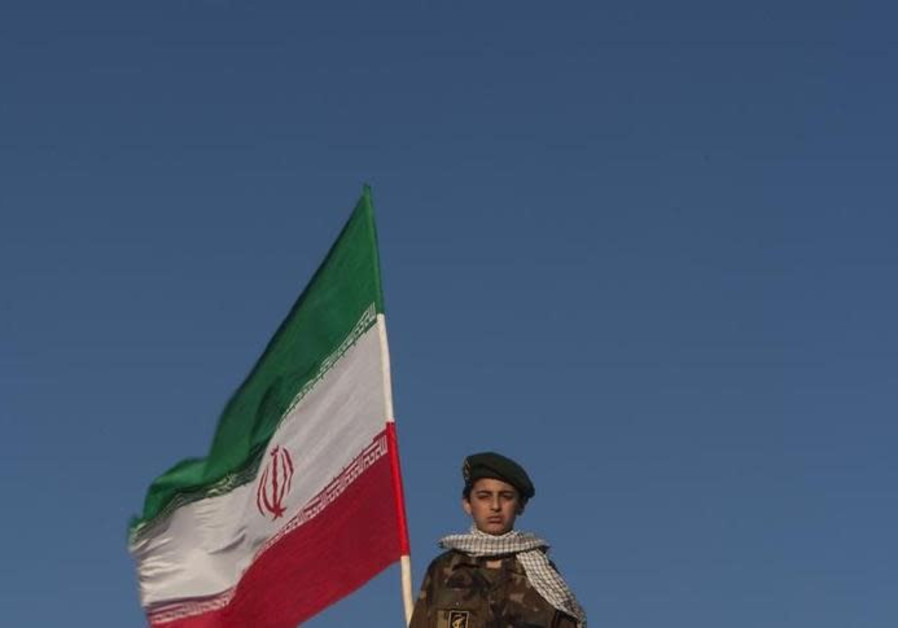It is a “$200 million giant,” the IRGC says, of the drone they brought down.
By Seth J. Frantzman
June 21, 2019 00:21
3 minute read.
A member of Iran’s Revolutionary guard stands guard next to an Iranian flag during an anti-US ceremony in Azadi Square in Tehran, April 25, 2010. (photo credit: REUTERS/MORTEZA NIKOUBAZL)
Iran’s Islamic Revolutionary Guard Corps were ecstatic on Thursday after announcing that they downed a US drone. An IRGC statement to Fars News explained that the drone, tracked from the southern part of the Persian Gulf, was carrying out an “espionage” mission, and when it entered Iran’s “territory” it was targeted and “defeated” by the IRGC. It is a “$200 million giant,” the IRGC says of the drone they brought down.
Not since the Soviet Union downed an American U-2 spy plane near Sverdlovsk (today’s Yekaterinburg) in 1960, or when Iran hacked into a US RQ-170 Sentinel drone in 2011 and landed it safely in Iran, has a foreign power served Washington with such an aerial embarrassment. Perhaps more attention should have been paid to Iranian media in recent weeks, as the country has been boasting about its abilities and sought to threaten US forces in the region.
On June 6, a US MQ-9 Reaper was shot down over Yemen, which seems like a $15 million toy compared to the hi-tech behemoth that the Iranians bagged on Thursday.
Iran also unsuccessfully fired at a different MQ-9 Reaper on June 13 during its attack on two oil tankers in the Gulf of Oman. Iran denied the attack, but the US has presented evidence of Iran’s involvement. After that attempt and now the loss of a sophisticated drone, questions have been raised concerning the level of Iran’s air defense technology. Iran rolled out a new air defense system called the Khordad 15 on June 10, and it was one of the Khordad systems, although not necessarily the June 10 version, that Iran says was used with its 75 km. range to take down the drone.
Iran says that it tracked the drone for 14 minutes as it flew toward Jask, where there is an Iranian naval base and where the attack on the oil tankers took place on June 13. The US has now clarified that the drone was a BAMS-D, a Broad Area Maritime Surveillance UAV, which was based on a Global Hawk model dating back to the late 1990s but has since been upgraded. Part of a multi-billion dollar program, the US Navy acquired several RQ-4A Global Hawks, keeping them in service while awaiting the delivery of the MQ-4C Triton.
According to Aviation Week, the Navy has been using versions of these aircrafts since 2009. Due to some confusion on Thursday, commentators believed that the drone was one of the latest Tritons, but the US later confirmed it was the BAMS-D.
The website The Drive revealed that the RQ-4s in use have a “full suite of electro-optical, radar, and electronic intelligence gathering systems.” It can spy from up high and “skirt along the edge of territorial boundaries to peer into a targeted country.” Basically, it is the U-2 of today without a pilot. The U-2 flew up to 23,000 meters, and the BAMS-D can reach altitudes up to 20,000; however, the height of the drone when it was shot down is unknown. It may have been as low as 16,000 meters. The US has said it was over international waters when it was brought down. Calculations based on different flight paths mean Iran’s missile might have had to travel up to 40 km. to hit it.
In the past month, Iranian-backed Houthis have been using drones on a nearly daily basis to attack Saudi Arabia. Not including the June 13 attempt on a US drone and the drone taken down by the Houthis on June 6, Iranian-backed groups have allegedly targeted US forces and personnel in Iraq on May 19, and June 14, 17, 18, and 19. Iran has also sabotaged six ships in the Gulf of Oman on May 12 and June 13.
Thursday’s incident is the icing on the cake of Iranian attempts to show the US that it means business. Washington has continually asserted that it does not want conflict, but has warned Tehran about “unrelenting force” if it attacks the US or its allies, which is why Iran was quick to explain that the drone entered its airspace.
The US is going through a change at the head of the Pentagon, as acting Defense Secretary Patrick Shanahan steps down leaving Mark Esper in charge. US President Donald Trump has said the US is prepared to deal with Iran.
The downing of the drone may have ramifications elsewhere if Iranian air defense are sent to allied neighbors. Iran has warned the US and its allies, including Israel and Saudi Arabia, of possible conflict saying “don’t threaten an Iranian.” On Thursday it made that warning clear.
Content retrieved from: https://www.jpost.com//Arab-Israeli-Conflict/Iran-shot-down-American-drone-to-showcase-its-air-defense-analysis-593150.
